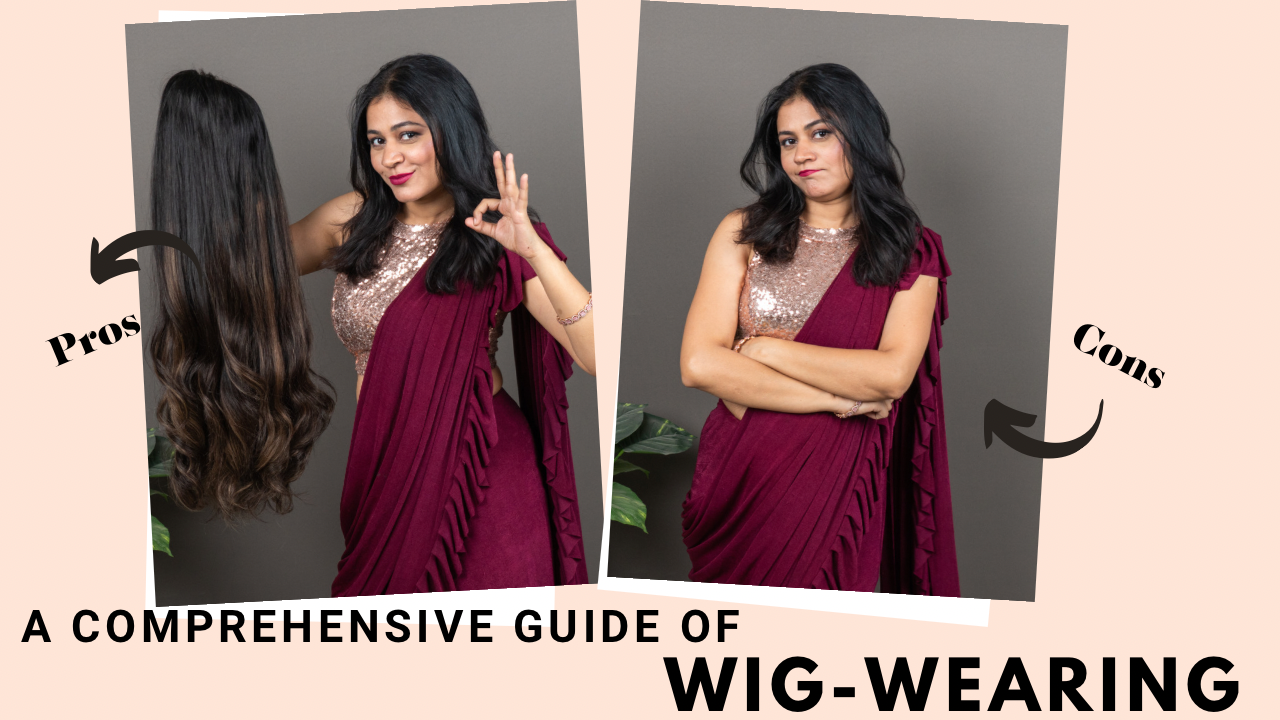Frizzy hair refers to hair that is characterised by an unruly, coarse, and frayed appearance. It often appears dry, tangled, and flyaway, with individual strands standing out from the rest of the hair. Frizz occurs when the hair's outermost layer, known as the cuticle, becomes raised or roughened, allowing moisture to enter the hair shaft and causing the hair to swell and become tangled.
This type of hair is a common concern for many, causing frustration and difficulty in achieving a sleek and polished look. However, fear not! With the right knowledge and a few simple tweaks to your hair care routine, you can bid farewell to those unruly flyaways and welcome the era of frizz-free hair. In this blog, we'll explore effective tips and tricks that will transform your hair into luscious, smooth, and frizz-free hair. So, let's embark on this journey to discover the secrets behind a confident and head-turning hairdo!
Know Your Hair Type

Understanding your hair type is essential to identify the unique needs of your strands. Different hair types require specific care routines. Let's break down each type and discover the best practices for frizz-free hair:
a) Straight Hair:
Straight hair tends to be more prone to oiliness at the roots and lacks natural volume. To manage frizz, use lightweight, sulphate-free shampoos and conditioners to avoid weighing down your hair. A volumizing mousse or spray can add lift to your locks, while a light serum or oil can tame any frizz at the ends.
b) Wavy Hair:
Wavy hair often falls somewhere between straight and curly, combining elements of both. Enhance your waves with a curl-enhancing shampoo and conditioner. Apply a curl-defining cream or gel to damp hair to reduce frizz and create defined waves. Avoid over-brushing your waves to maintain their natural shape.
c) Curly Hair:
Curly hair thrives on moisture. Look for hydrating shampoos and conditioners that promote curl definition. Use a wide-tooth comb or your fingers to detangle your curls gently. Apply a leave-in conditioner or curl cream to enhance and control your curls' shape and minimize frizz.
d) Coily Hair:
Coily hair has tight, springy curls and requires ample moisture to maintain its health and prevent frizz. Use a moisturising shampoo and deep conditioning treatment regularly. Seal in moisture with natural oils like jojoba or grapeseed oil. Style your coily hair with protective hairstyles like braids or twists to reduce frizz caused by manipulation.
Hydration - The Key to Frizz-Free Success

One of the most vital elements for managing frizz is adequate moisture. Dry hair is more prone to frizz, so it's crucial to keep your hair hydrated and nourished.
a) Shampooing
Choose hair products that are sulphate-free and gentle on your hair. Sulphates can strip away natural oils, leading to dryness and frizz. Opt for moisturising shampoos that cleanse without over-stripping your hair.
b) Conditioning
Conditioning is essential for maintaining frizz-free hair. Invest in a high-quality conditioner that suits your hair type and use it after every shampoo. Leave-in conditioners can provide extra moisture and protection throughout the day.
c) Deep Conditioning Treatments
Incorporate deep conditioning treatments into your hair care routine at least once a week. These treatments provide intense hydration and repair damaged hair, helping to minimise frizz over time.
d) Oiling
Using natural oils as part of your hair care routine can work wonders for frizz-prone hair. Coconut oil, argan oil, and jojoba oil are excellent choices to lock in moisture and reduce frizz.
Invest in the Right Hair Care Products

The key to unlocking frizz-free hair lies in using the right hair care products. Opt for sulphate-free and silicone-free options as they help maintain the natural oils in your hair, preventing frizz.
a) Sulphate-Free Shampoos:
Sulphates are harsh detergents that strip away the natural oils in your hair, leaving it dry and prone to frizz. Choose sulphate-free shampoos to cleanse your hair gently without compromising its moisture.
b) Silicone-Free Conditioners:
Silicones can provide a temporary smoothness but can also weigh down your hair and lead to product buildup. Look for silicone-free conditioners that nourish your hair without leaving behind residue.
c) Frizz-Controlling Serums and Creams:
Frizz-controlling serums and creams can be your best friends in the fight against frizz. These products help seal the hair cuticle, preventing moisture from escaping and minimizing frizz. Apply a small amount to damp hair and distribute it evenly for the best results.
d) Hair Masks:
Treat your hair to a luxurious hair mask once a week. Hair masks are deep conditioning treatments that penetrate the hair shaft, providing intense hydration and nourishment.
Practice Smart Washing and Drying

Overwashing can strip your hair of its natural oils, leading to frizz. Aim to wash your hair 2-3 times a week to maintain its natural balance. When drying your hair, pat it gently with a microfibre towel instead of rubbing vigorously to avoid causing frizz.
a) Proper Hair Washing Technique:
When washing your hair, focus on massaging the scalp to cleanse it thoroughly. Avoid piling your hair on top of your head as this can cause tangles and damage. Instead, gently squeeze the excess water out of your hair without wringing it.
b) Drying Techniques:
Avoid using terry cloth towels as they can rough up the hair cuticle and promote frizz. Instead, use a microfiber towel or an old t-shirt to blot excess moisture. If you prefer blow-drying your hair, use a diffuser attachment to minimise frizz and preserve your natural curls.
Embrace Air-Drying and Minimise Heat Styling

Minimise the use of heat styling tools to protect your hair from damage and frizz. Air-drying your hair whenever possible is an excellent way to maintain its natural texture and avoid unnecessary heat exposure.
a) Air-Drying Tips:
After washing your hair, gently squeeze out excess water with a microfibre towel or t-shirt. Let your hair air-dry for a while before styling or using any products. Avoid touching or tousling your hair too much during the drying process, as this can disrupt the natural pattern and lead to frizz.
b) Limit Heat Styling:
Heat styling can damage your hair and exacerbate frizz. Embrace your natural hair texture and opt for hairstyles that require minimal heat. If you do use heat styling tools, apply a heat protectant spray to shield your hair from damage.
Regular Trims and a Consistent Haircare Routine
Say goodbye to split ends and welcome healthy hair with regular trims. A consistent hair care routine that includes deep conditioning treatments and hair masks will keep your hair nourished and frizz-free.
a) Regular Hair Trims:
Trimming your hair every 6-8 weeks helps remove split ends and prevents them from travelling up the hair shaft. Regular trims also maintain the shape and health of your hairstyle, keeping your hair looking its best.
b) Deep Conditioning Treatments:
Incorporate deep conditioning treatments into your hair care routine to provide much-needed hydration and repair damaged hair. These treatments keep your hair strong, healthy, and frizz-resistant.
c) Hair Masks:
Treat your hair to a weekly hair mask to intensively nourish and strengthen your strands. Look for masks containing ingredients like shea butter, avocado oil, or honey, which provide deep hydration and promote smoothness.
The Power of Protective Hairstyles
Protective hairstyles can be a game-changer when it comes to frizz control. Opt for braids, twists, buns, or use silk or satin scarves at bedtime to minimise daily hair manipulation and reduce frizz.
a) Braids and Twists:
Braiding or twisting your hair can help protect it from environmental factors that contribute to frizz. Choose loose and gentle styles to avoid stressing your hair.
b) Buns and Up-dos:
Wearing your hair in a bun or up-do can keep your ends tucked away and shielded from damage, helping to maintain frizz-free locks.
c) Silk or Satin Scarves and Bonnets:
Wrapping your hair in a silk or satin scarf or wearing a satin bonnet while sleeping can reduce friction and prevent frizz-causing hair breakage.
Sleep on Silk or Satin
Sleeping on a silk or satin pillowcase can work wonders for your hair. The smooth surface reduces friction, preventing hair breakage and reducing frizz.
Benefits of Silk and Satin Pillowcases:
Unlike cotton pillowcases, silk and satin allow your hair to glide smoothly, reducing friction and minimising frizz. Additionally, these materials are gentle on your skin, preventing wrinkles and maintaining a fresh complexion.
Conclusion
Achieving frizz-free hair is an achievable goal with the right knowledge and dedication to proper hair care. Embrace your natural hair texture, follow the tips and tricks mentioned in this blog, and enjoy a beautiful, smooth, and frizz-free mane. Remember, consistency is key, and patience will lead you to hair that shines with health and confidence. Let your hair do the talking as you walk with your head held high and a smile on your face, knowing that frizz is now a thing of the past. Here's to your journey towards gorgeous, frizz-free hair!
And you can always opt for hair extensions and hair wigs to complement your hair even more. This gives you the possibility of exploring different hair styles every single day, if you want to. Gemeria offers a vast range of different hair extensions and hair wigs to suit your needs and preferences.



